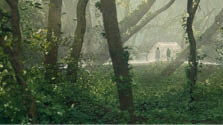doxa.comunicación | nº 31, pp. 207-238 | 233
July-December of 2020
Ana Isabel Cea Navas and Sergio García Rubio
ISSN: 1696-019X / e-ISSN: 2386-3978
and being free. Deakins expresses the idea of freedom in the character Joi, who moves around autonomously in an environment bathed in this colour (figure 32). Similarly, when K suspects that he might be a replicant’s son, the image contains this pigment (Figure 33),
It is also worth mentioning the forest scene, where we can see Deckard’s daughter and the replicant. Although it is a hologram, it does not live since it is enslaved, a state that breaks away from the film’s philosophy (figure 34).
Another remarkable colour in the film is white, associated with the truth (cf. in table 3). The room where Deckard’s daughter is confined is in this tone, and her clothing coincides with this chromatic range. This colour influences the meaning of the work; since she is the one who is looking for K, it is the key to his investigation. And something is striking in the composition of the images in the scene between K and Deckard’s daughter, regarding the use of this white, the first time the main character speaks to her, he does not know the truth. Here we can see that he goes outside to a partial snow-covered place (figure 35); later, when K finds out the truth, the same area is completely covered in snow (figure 36).

Source: Fotograma Blade Runner 2049
Figure 34. A holographic image of a forest
Source: Fotograma Blade Runner 2049
Source: Fotograma Blade Runner 2049
Figure 32. Image of Joi (a sign of freedom)
Figure 33. K reflects on his origin